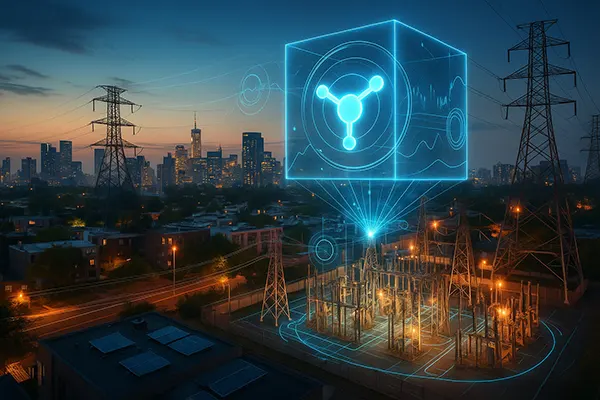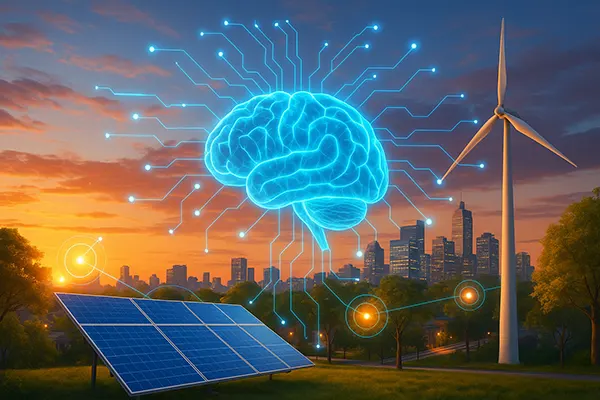
Energy Hubs of the Future: How AI Will Manage Smart City Power Grids
As urbanisation continues to accelerate, cities worldwide are seeking smarter, more resilient energy infrastructures. The integration of artificial intelligence (AI) into urban power grids is revolutionising how electricity is distributed, consumed, and conserved. In February 2025, this transformation has become not only a technological opportunity but a pressing necessity. AI-based energy hubs are emerging as the core of these efforts, offering cities real-time adaptability, decentralised management, and predictive maintenance.
Artificial Intelligence in Power Grid Infrastructure
AI technologies are playing a pivotal role in the evolution of smart grids. With increasingly diverse energy sources—such as solar, wind, and bioenergy—cities need more dynamic ways to balance energy supply and demand. AI systems enable this by forecasting consumption patterns based on historical data, real-time sensor input, and external variables like weather or traffic. These capabilities help prevent outages and optimise the energy flow across districts.
In practice, smart meters and grid nodes are now often interconnected through AI-driven platforms. These platforms can detect faults instantly and redirect power flow accordingly. For example, in London’s boroughs, the implementation of smart grid software has reduced response time to power faults by over 60%, according to Q1 2025 statistics published by UK Power Networks. AI not only boosts efficiency but also helps to lower operational costs.
Beyond technical functionality, these AI systems support the integration of distributed energy resources (DERs) into local grids. This includes household solar panels, electric vehicle (EV) charging stations, and residential batteries. With AI’s assistance, these elements can contribute energy to the grid autonomously, creating a more resilient and decentralised energy ecosystem.
Machine Learning Models Driving Energy Forecasting
Machine learning (ML), a subset of AI, is the cornerstone for accurate energy forecasting. ML models analyse consumption patterns from millions of endpoints, learning and adapting as new data is introduced. By February 2025, these models have become far more efficient at making predictions for both short- and long-term energy planning.
For instance, in cities like Copenhagen and Amsterdam, AI-powered energy hubs have been instrumental in adjusting power generation during unexpected weather fluctuations. This ensures minimal disruption to consumers and better utilisation of green energy. These models factor in real-time updates from satellites, IoT devices, and public transport usage data to fine-tune the demand response systems.
In addition to forecasting, ML plays a crucial role in anomaly detection. Any irregular energy behaviour—such as voltage spikes or sudden usage drops—is instantly flagged, analysed, and acted upon. This has significantly reduced the occurrence of blackouts in test regions where AI-grid integration is active.
Energy Hubs and Urban Sustainability
AI-powered energy hubs are vital to achieving urban sustainability goals. These hubs serve as control centres that monitor and regulate the energy flow within a neighbourhood or district. In February 2025, many European cities are piloting these technologies to align with their carbon neutrality targets.
One of the key strengths of energy hubs is their capability to facilitate demand-side energy management. Through automated systems, buildings can adjust heating, cooling, and lighting based on occupancy, time of day, and energy tariffs. This significantly reduces wastage and enables smarter energy use at the community level.
Moreover, energy hubs support the integration of renewable sources by managing intermittent supply. For example, solar generation peaks during the day, while residential demand surges in the evening. AI algorithms match these temporal mismatches by drawing from local energy storage or rerouting supply from other sources. This ensures stability while enhancing the use of clean energy.
Energy Equity Through Decentralised AI Systems
AI energy hubs are also promoting energy equity by decentralising control and allowing communities to manage their own energy resources. In some UK cities, energy cooperatives now use AI software to oversee microgrids, enabling residents to produce, store, and trade electricity locally.
This shift has made energy systems more democratic. Instead of relying solely on large utility companies, local actors can actively participate in the energy market. AI handles the complex optimisation tasks behind the scenes—such as adjusting battery storage levels or setting fair pricing—making participation viable even for those without technical expertise.
Additionally, decentralisation increases resilience against external shocks like cyberattacks or natural disasters. Local grids can isolate themselves from central networks when necessary, keeping vital services running and communities safe during disruptions.

The Road Ahead: Challenges and Opportunities
Despite the progress, integrating AI into urban energy systems comes with challenges. Data privacy, cybersecurity, and regulatory barriers remain significant concerns. As of early 2025, energy authorities are working closely with technology firms to establish ethical frameworks and cybersecurity protocols to protect users and infrastructure.
Another hurdle is the digital divide. Not all municipalities have equal access to high-performance computing infrastructure or skilled labour to manage AI tools. Bridging this gap will require public-private partnerships and funding initiatives aimed at technology transfer and workforce development.
Nevertheless, the opportunities outweigh the hurdles. AI is not just a support tool—it is becoming a cornerstone of energy planning. As cities aim for climate neutrality, AI will empower decision-makers with precise insights and tools to manage resources efficiently, fairly, and sustainably. The future of urban energy is intelligent, decentralised, and citizen-driven.
Policy Frameworks Enabling AI-Based Energy Innovation
To fully harness AI’s potential, governments must implement adaptive and forward-thinking policy frameworks. In February 2025, several nations, including Germany and the UK, are revising their national energy strategies to include AI benchmarks and guidelines for ethical deployment.
These frameworks address transparency, accountability, and data governance, ensuring AI systems are used responsibly. For example, the UK’s “AI for Infrastructure” initiative outlines standards for how energy data must be stored, anonymised, and shared to promote collaboration while protecting individual privacy.
Funding is another critical area. EU Horizon programmes and local green investment funds are now offering grants specifically for AI energy projects. These policies not only support innovation but also ensure equitable access to cutting-edge energy technologies for all regions, urban and rural alike.
